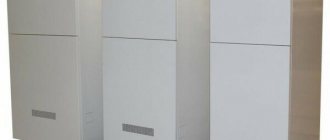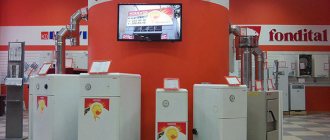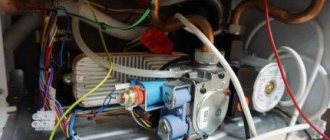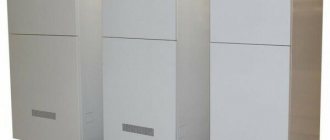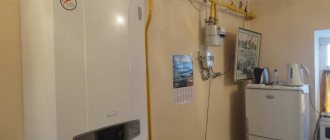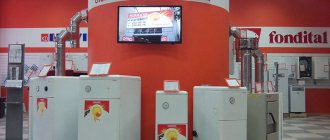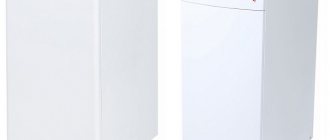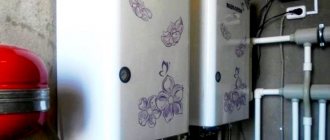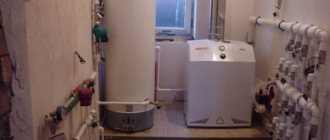Please help me with the following problem. We recently replaced an old Soviet boiler with a 12 kW Conord boiler produced in Rostov-Don. They started heating, and there was a problem with the smell in the room, i.e. the boiler turns on and off, the system heats up, but after 2-3 hours a certain smell and a suffocating atmosphere appears, all this is accompanied by poor health, headache, etc. Chimney increased to 120 mm (according to the output of the boiler), the height is 5.8 m, while the norm according to the instructions is 5 m, there seems to be a draft when holding a lit match. There is a suspicion of incomplete combustion. The service technician reduced the gas supply, only the heating time of the system changed. According to him, the boiler is working properly. Tell me what to check? Or give up and replace it with something else while there is time before the cold weather. The flame is blue at the bottom and yellowish-reddish at the top. Until we turned down the gas, it burned well with a hum. Automation Honeywell, I can’t say more precisely now. Model KSC-GV. The fact is that the master believes that everything is in order with the device and is not going to do anything else. But at the same time, it is still very difficult to breathe (today they extended the chimney additionally by about +1 m), the effect is minimal, i.e. the draft is somewhat better, but the gas pollution remains.
The boiler must not be used until the fault is corrected! Most likely there is a problem with the smoke exhaust. It is possible that when installing a new pipe, some cracks were formed through which fumes escape into the room. Take out the burner and light something smoky in the firebox, but not poisonous like sulfur. See if there is smoke coming into the room from where. Do it as a team, not alone. Ask local fire departments who inspect chimneys to see if they have a special compound for the color of the smoke. It is possible that the new pipe is inserted too far into the chimney and almost touches the chimney wall. But there are still gaps somewhere in the room, maybe the pipe is hanging out at the outlet of the boiler? In general, do not use the device until the cause is eliminated. The pipes must be inserted into each other along the gas flow at least 50 mm. Everything should be tight, only the unit itself may have a hole for the traction sensor.
The gas boiler Conord KSC-G-12N with Honeywell automation (V9500 (V5475) is in operation. It has been working for about 3 years, but from time to time there are problems with igniting the pilot/main burner. Actually, I have two questions: 1) How to set up the automation ? I searched, but couldn’t find current advice on setting up the automation. 2) How to disassemble and clean the boiler? For 3 years it has never been cleaned. The reason is banal, I don’t know how to take it apart and I’m afraid of damaging something. Maybe someone will give instructions for disassembly or some sensible advice.
Malfunction of the Conord boiler with Honeywell automation. Model KSC-GV-10. The device is new. Gas turned on. The pilot burner ignites when the plastic button is pressed. When released it goes out. Doesn't turn counterclockwise. It rotates clockwise by a very small degree. The copper coil gets hot.
I would start by checking the voltage on a heated, disconnected thermocouple. If it is less than the minimum, about 20 microvolts, then the igniter flame may be blown or, more likely, the igniter nozzle or tube is clogged. Then I would clean all possible automation contacts, as well as electrical contacts.
Conord floor heating boiler with Honeywell automation (gas valve V8620). The device heats up to approximately temp. 65-70 degrees, I determine it from the pipe that comes out of the boiler, and then the main burner and pilot are turned off, and until the temperature drops to 50 degrees, the main burner will start and go out after 3-5 minutes, blowing out the pilot.
Perhaps the overheating sensor is faulty and not only that.
Malfunction of the Conord KS-20 boiler. It was turned off for the summer. In connection with the upcoming onset of cold weather, I decided to test the water and discovered that the liquid temperature indicator had fallen out. How and when it fell out is a mystery, shrouded in darkness (no one admits it). I called a gas mechanic, but he will only come on the weekend. Therefore, the question is whether it is possible to turn on the device with such an indicator, at least in the evening for an hour or two.
Yes, you won't see the temperature. And in the future, replace it. Take out the old one and insert the new one. There is no need to drain the water.
Incorrect operation of the burner (automation AGU-T-M 23). Gas floor-standing boiler Conord. Tell me how to properly repair it. The problem is this: It regulates and turns off the gas supply very poorly. That is, it probably doesn’t regulate at all. The sensor with antifreeze built into the boiler should heat up and, expanding the antifreeze, blow out the rubber membrane, and the membrane should shut off the supply. I repaired this thing 2-3 years ago - I completely removed the sensor with a copper tube, with a block tap and put everything in the freezer, then unscrewed it, tapped it to keep it from airing and added a couple of cubes of antifreeze. Now it doesn't help. If you turn off the electricity, the boiler will boil, even if the tap block is barely open. Maybe there needs to be a membrane replaced or a fluid or I don’t know what.
The steps are as follows: Turn off the gas. (In general, it is advisable to do everything on a cooled thermal cylinder). Unscrew the 2 bolts on the thermostat and remove the thermostat rod. Inspect the rod, it is plastic, as a rule, it is crushed with excessive force (if it is crushed, then replace it). If the rod is intact, then change the 2 rubber rings on it and lubricate it with grease. Do not skimp on the grease on the rings and do not forget to lubricate the inside of the thermostat glass. Before installation, pull out the aluminum ring (there are usually 2 of them on the cotter pin between the rod and the thermostat cover) and unscrew the rod all the way up. Pull up the lower part (brass, where the membrane with antifreeze is). After this, insert the rod into the glass and tighten the 2 bolts. Before lighting, be sure to tighten the handle, but do not over-tighten it. Check if everything works as it should.
teplomex.ru
Gas boilers Conord: review, design, automation
It's no secret that imported floor-standing gas boilers are of higher quality compared to domestic boilers.
This applies to the material used to make the elements, the reliability of the automation, and the assembly of the device. However, the price of imported analogues differs noticeably upward. Our task is to find a Russian-assembled gas boiler with an optimal price-quality ratio. I propose to disassemble Conord floor-standing gas boilers, reviews of which can increasingly be found on various thematic forums. Let's consider the model range, technical characteristics, device, types of automation (gas burner devices), using the instructions for use.
Model range and description of Conord boilers
Conord floor-standing gas boilers are available with capacities from 8 to 30 kW. They come as single-circuit: KSts-G-8, KSts-G-10, KSts-G-12, KSts-G-16, KSts-G-20, KSts-G-25, KSts-G-30;
and double-circuit: KSts-GV-10, KSts-GV-12, KSts-GV-16, KSts-GV-20, KSts-GV-25, KSts-GV-30.
Single-circuit ones can only be used for heating from 30 to 300 m2. Conord double-circuit gas boilers can be used for both water heating and hot water supply (DHW).
Floor-standing gas boilers Conord
It is important to note that if you need a double-circuit boiler to fully use the DHW circuit, you need to buy a Conord boiler with a power rating of 20-25 kW. In this case, it will produce about 10-12 liters of hot domestic water per minute
There is no point in buying, for example, a double-circuit boiler KSts-GV-12 with a power of 12 kW. It will not give us a good volume of hot water.
Boilers can be used in both open and closed heating systems.
Installation of floor-standing gas boilers Conord
The boiler consists of a steel firebox 3 mm thick, a casing, a water jacket, smoke pipes with turbulators built into them to increase the efficiency of the boiler, a gas burner device (automation), a layer of thermal insulation made of basalt cardboard, and a thermometer to monitor the temperature of the coolant. In double-circuit models, a special coil for the water circuit is installed around the smoke pipes.
The coolant inlet and outlet, as well as the DHW coil, are located on the rear side of the boiler body. The thread diameter of the heating connection pipes for all models of this brand is 2 inches or 50 mm. For DHW circuit 1/2 or 15 mm. The chimney diameter for models with power from 8 to 12 kW is 115 mm, for 16 kW and above - 150 mm.
Conord boiler design
Due to the built-in turbulators and good thermal insulation, the efficiency of the Conord boiler reaches 90%. These heating devices are capable of operating at reduced gas pressure and are completely energy independent of electricity. The manufacturer claims a boiler service life of 15 years and a factory warranty of 3 years, which is also indicated in the operating instructions.
Automation for gas boilers Conord
Three types of automation can be installed on floor-standing boilers of this brand:
— domestic type AGU-T-M
- Italian Euro SIT
In general, the automation, although not particularly sophisticated, is unpretentious. In the event of a breakdown, it is not difficult to find spare parts for it. For example, a bimetallic strip that often fails costs about 50 rubles.
Automation type AGU-T-M
Euro SIT automation consists of a sectional burner and Polidoro tubes, as well as a safety system: igniter with thermocouple, temperature sensor, SIT gas valve, draft sensor and wires. If the pilot burner goes out, the gas is turned off, or there is no draft in the chimney, the automatic system instantly shuts off the gas supply to the burner.
Ignition occurs by pressing the piezoelectric element button or using a match. The coolant temperature is provided by the gas valve and set by the thermostat knob.
Automation Euro SIT
Honeywell automation from an American manufacturer has similar technical characteristics to a Euro SIT gas burner device. The principle of operation is the same, it differs mainly in the manufacturer and material of some elements.
Ignition is carried out by pressing the handle to the right of the thermostat and then turning it to the stop position to operate the boiler in economical mode.
Advantages of Conord gas boilers
- wide range of models
— three types of automation
— in case of boiler malfunction it is easy to find spare parts
Series and model range
First of all, you should understand the markings of Conord boilers.
It is an abbreviation in which the first letters indicate the heat exchanger material:
- KSC is a steel boiler with a cylindrical heat exchanger.
- KCH - cast iron boiler.
The following letters indicate the feature set:
- G - single-circuit (gas).
- GW - double-circuit (gas with the possibility of hot water supply).
Then follow the numbers indicating the boiler power in kilowatts and the letter indicating the type of automation:
- N - thermohydraulic.
- S - Italian automatic SIT.
For example, a boiler marked KSts-GV-10N means a steel boiler with a cylindrical heat exchanger, double-circuit, 10 kW power with thermo-hydraulic automatic control.
Conord boilers are produced in the following series:
- KSC-G-S . A series of single-circuit units with Italian automatic equipment. They have a piezo ignition system, an additional ignition burner, and a special thermocouple is used for ignition. Designed for heating rooms from 80 to 500 m2, you just need to select a unit of appropriate power. The model range consists of units of 8, 10, 12, 16, 20, 25, 30, 40 and 50 kW.
- KSC-G-N . Single-circuit models with mechanical automation. A special feature of the series is the ability to work in systems with high pressure - up to 5 bar. The power of the models is 10, 12, 20, 25 and 30 kW, which allows you to heat rooms from 100 to 300 m2.
- KSts-GV-S . Double-circuit gas boilers with Italian automatic operating mode control. The power of the models is 8, 10, 12, 16, 20, 25 and 30 kW. This allows you to successfully operate the equipment in rooms from 80 to 300 m2. They have the ability to provide a home not only with heat, but also with hot water, which significantly increases their value for the user and allows them to solve two problems at once.
- KSts-GV-N . Double-circuit boilers with a capacity of 12, 20, 25 and 30 kW. They have a thermo-hydraulic type of automation. They provide heating and hot water supply, designed for use in rooms from 120 to 300 m2.
- KCH-G-S . Single-circuit boilers with a cast iron heat exchanger and Italian SIT automation. Three models are available with outputs of 16, 25 and 30 kW. These units are the most expensive, highly efficient and reliable. They weigh twice as much as steel boilers of the same power.
The model range is quite wide and allows the user to get the best option for the existing conditions.
Review: Floor-standing single-circuit gas boiler Conord KSts-G-12N - Reliable and economical!
Advantages:
Inexpensive, works properly, economical, 3 year warranty
Flaws:
there are small ones
Gas heating has its pros and cons. On the one hand, living in an apartment, you don’t have to bother with boilers, installing them somewhere, periodically cleaning them, lighting them, etc. You wait until the heat is turned on, and that’s it. But on the other hand, they don’t always turn it on when you want. And you have to freeze without heating in the fall and spring, and sometimes, on the contrary, die from the heat. This is a huge advantage of gas heating - when you need it, you turn it on, when you don’t need it, you turn it off. We live in a private house, and we, in fact, don’t have to choose: if you want heat, install a boiler. So we installed the Conord KSts-G-12N when the previous one gave up its life.
Some technical data: overall dimensions 412/342/786, weight about 40 kg. Designed for 120 square meters (we have 100, we took it with a small margin). The efficiency is stated to be at least 90%, but how to check this? Gas consumption at nominal heating output is indicated at 1.35 cubic meters per hour. The boiler is steel, white, covered with heat-resistant powder enamel. All the “stuffing” is behind the door:
As you can see in the photo, the top cover is loose - this is not a defect in the boiler, it was after a preventive inspection and cleaning that the gas workers (!) installed it incorrectly, we didn’t notice right away, but we didn’t want to disassemble, remove the pipe and redo it ourselves, so we decided to leave it until next time . This boiler model is single-circuit; we use a gas water heater to heat water. The boiler is non-volatile, but our heating is with a circulation pump, i.e. when the power goes out, the pump does not work, the boiler overheats and automatically turns off. Fortunately, this rarely happens. There is one inconvenience during the initial ignition - you need to hold the button pressed for a while, your finger gets tired)
The instructions are the same for several models, for me personally it is not very clear, but still boilers should be installed and maintained by specialists, or at least technically competent people, this is not about me:
The boiler does not, of course, have all sorts of useful and pleasant functions such as programmable switching on at a certain time and the like, like its more expensive counterparts. But the manufacturer gave a 3-year warranty, and the promised service life is at least 15 years. The boiler was installed in the summer of 2010 and survived 2 winters. It was not very warm at home only in the most severe frosts of 30 degrees. In general, everything is fine so far, only this spring, however, it unexpectedly began to smoke, I had to urgently clean it (I confess, it was cleaned for the first time, although it needs to be at least once a year). It is more economical compared to the previous boiler, heating a 2-storey house with an area of 100 sq. m., an average of 500 cubic meters per month is consumed (naturally, more in winter, much less in summer, but I’m used to paying one amount all year round, it’s more convenient for me). PS Unfortunately, we have to add a fly in the ointment to the previous positive impression. Today it suddenly started smoking again, 9 months have passed since the previous cleaning. So, during cleaning, specialists removed one of the turbulators and discovered that it had burned out in one place. After less than 3 years of work.
Use time: 2 years
Cost: 9600 rub.
Year of manufacture/purchase:2010
General impression
.
Reliable and economical!
What are they?
If you are interested in the products of the Rostov manufacturer, you can choose a boiler from four series.
- With Italian automatic equipment SIT: KSts-G-S/ KSts-GV-S - single-circuit/double-circuit.
- With thermo-hydraulic automation: KSts-G-N/KSts-GV-N - single-circuit/double-circuit.
The manufacturer offers heating boilers with two types of heat exchangers: steel and cast iron. All gas heaters produced by the Rostov enterprise are only floor-standing. If you're interested in a wall-mounted unit (with a closed firebox), you'll have to look to a different brand.
Steel
Heaters with steel heat exchangers have the following advantages:
- Steel is more ductile compared to cast iron.
- Specific gravity is less.
- High heat dissipation.
There is one minus, but a very important one - low resistance to damage and corrosion. That is why consumers who know a lot about materials choose cast iron analogues. Manufacturers try to minimize this by using durable coatings, but they cannot provide 100% corrosion protection.
Cast iron
The main advantages of cast iron heat exchangers: high thermal conductivity and immunity to corrosion.
- Cast iron is less flexible and ductile than steel and is not as resistant to deformation.
- Inferior to steel in strength.
- Brittleness is the main disadvantage of cast iron. Particularly dangerous situations arise during transportation and installation, which is why installation should be entrusted to specialists. After delivering the device home, be sure to check the integrity of the cast iron heat exchanger. Even the presence of microcracks is a most dangerous situation for equipment. If they appear, the equipment will soon fail and the heat exchanger will need to be replaced.
Installation features
We have already said that boilers are highly efficient and can last quite a long time. However, in order for all these key points to be effective, it is necessary to carry out the correct installation of the equipment, which should be entrusted to specialists. Service center employees are required to make notes about the operations performed in the technical passport of the heating unit. In addition, specialists must annually inspect the boiler and all its components; this must also be indicated in the technical passport.
When installing equipment, it is necessary to take into account a number of requirements that apply to the Conord heating boiler:
If the unit is placed on a combustible floor, then it is necessary to take care of a fireproof substrate, which should be larger in size than the device itself by 50 cm on both sides. To ensure normal water circulation in the system, the lower pipe must be located lower than the heating radiators. The pipes in the system may be different. If they are connected by welding, it is recommended to leave a pair of threaded connections for future repairs. Laying of horizontal sections should be carried out with a slope for air removal of at least 10 mm per 1 meter from the structure itself. A prerequisite is vertical risers; a deviation of three millimeters per three meters of the structure is allowed; the angle of inclination of the outlet to the heating devices should be 10 mm per 1 m of pipe. At the outlet of the coil, you should install shut-off valves. The finished chimney to which the equipment will be connected must be located in the load-bearing wall of the building. It is advisable to cover the chimney with thermal insulation, especially if it passes through an area that is not heated. The diameter of the chimney should in no case be greater than the diameter of the outlet pipe. This is a prerequisite for stable operation of the equipment and sufficient traction. Make sure there are no ledges at the chimney
It is also important that it is positioned strictly vertically. All indicators must be strictly observed, in accordance with regulatory documents and fire safety rules
If you are going to install a Conord gas boiler, be sure to coordinate your actions with specialized authorities.
Types and characteristics
Conord floor-standing devices are available with different powers - from 8 to 30 kW. They come with one circuit: these are models KSts-G-8 and KSts-G-10, KSts-G-12 and KSts-G-16, KSts-G-20 and KSts-G-25, as well as KSts-G- thirty; and with two circuits: KSts-GV-10 and KSts-GV-12, KSts-GV-16 and KSts-GV-20, KSts-GV-25 and KSts-GV-30.
Each letter in this case will have its own meaning:
- “K” is the name of the device – “Boiler”.
- “C” is the type of material from which the boiler is made. In this particular case it is steel.
- “C” – the firebox is released in the form of a cylinder.
- “G” - without other letters nearby will mean that in front of you is a gas unit.
- The letters “DHW” will show you that in a particular case there is a product with a DHW function in front of you.
- The numbers in this name indicate the level of the maximum power indicator of the device. When selecting these parameters, you need to take 1 kW to heat a room of 10 m2 with a wall height of no more than 2.5 m.
Thus, the KSts-GV-12 device is a steel boiler with a cylinder firebox, having a hot water supply function and a maximum power of 12 kW. Products with one circuit are selected only for heating a home with an area of 30 to 300 m2. Double-circuit devices from Conord can be used for heating and for producing heated water.
In the line of this popular brand there are almost no options for models for walls; for this reason, for their home heating system, ordinary people buy floor-standing boilers, which sometimes have a number of additional features. Floor products are produced in 4 popular series. The plant produces all units from high quality steel. To improve the durability of the boiler, a special powder layer is applied to its body, which will protect the device from exposure to fairly high temperatures and severe loads.
KSC-G-S
In this series you can easily find an excellent device with one circuit, which will also be equipped with a fairly convenient regulator for fuel supply. Imported automation, which is necessary to control the entire operation of the product, guarantees its complete safety. Devices from this series can be adapted to heat buildings with areas from 80 m2 to 300 m2, but you must choose the right boiler according to its power.
Overview of markings and its interpretation
You can find out about some of the technical characteristics of the boiler if you pay attention to the markings. It may have the following form: KSts-G-10S or KSts-GV-12
The letter "K" stands for "cauldron". The letter “C” indicates that it is made of steel. If the design has a cylindrical firebox, you can recognize this by the letter “C”.
Gas boiler equipment is designated by the supplier with the letter “G”. If you have a boiler in front of you that provides the function of hot water supply, then you can find out about this by two letters - “GW”. After the letter designation you will see numbers. They indicate the maximum power level.
In order to determine the required power when purchasing a boiler, the area of the room is taken into account. For every 10 m2 you will need 1 kW of power. This is true if the ceiling height is 2.5 m
It is important to consider that this choice is relevant for the average level of heat loss
Floor steel models Conord
Let us immediately note that all boilers of this brand are produced in a floor-standing version. “Steel” boilers are those whose heat exchanger is made of steel. It is easy to find such a device in a catalog or price list by the marking, which begins with the letters “KS” (steel boiler).
For example, it is the steel heat exchanger that is installed in the boiler of the KSC-G-16 brand.
Here the letter “C” denotes the cylindrical shape of the heat exchanger, “G” is the type of fuel (gas), and the number “16” is the power in kilowatts.
The presence of the letter “B” in the marking (for example, KSC-GV-20) means that the boiler is 2-circuit.
Boilers with a steel heat exchanger are lighter and heat up quickly. However, they are less reliable and not as durable as cast iron. A significant disadvantage of steel is its susceptibility to corrosion.
Advantages and disadvantages
The positive features of gas appliances from Conord can be determined according to the reviews of those owners who actively use them:
- large model range;
- models have 3 types of automation;
- efficiency;
- high efficiency;
- in the event of a boiler breakdown, you can find spare parts quite quickly;
- good thermal insulation;
- guarantee of flawless operation for 3 years;
- uninterrupted operation for almost 15 years;
- steel heat exchangers help withstand thermal deformations;
- the use of water from the water supply system as a coolant;
- the ability to connect to a system with various types of circulation of the working environment;
- almost complete absence of wall-mounted appliances;
- energy independence of devices;
- use in certain series of automation parts made in Italy and Poland;
- simplified process of using the device.
Boilers from this manufacturer are created in accordance with the characteristics of the domestic climate and are designed to generate the required amount of heat to warm the home even in the most severe frosts.
The reliability of these popular devices is guaranteed by the increased level of durability of heating devices, and their independence from electricity will allow them to function without any failures or delays, especially in conditions where there is no electricity.
The low level of noise impact during operation, compact size and stylish design will allow you to place the device in the kitchen or any other room without harming the design of this room.
A gas unit with 2 circuits from Conord can heat the room as quickly as possible, and also provide home owners with heated water for personal needs.
The safe operation of the products is guaranteed by the arrangement of various protection components of the automation box, which will help turn off the product when the traction is lost. In addition, the boiler will be turned off in the event of any breakdown or any other type of failure. You will be able to automatically adjust the heating temperature of the device, and if the fuel pressure level is too low, the device will provide rapid forced air injection to maintain the functionality of the device.
Disadvantages of Conord products:
- not the highest build quality of some models;
- the steel thickness will be no more than 3 mm;
- ban on the use of antifreeze.
Advantages and disadvantages
The advantages of Conord gas boilers include:
- High quality assembly and manufacturing of components and parts.
- Boiler efficiency exceeds 90%.
- The non-volatile design allows the units to be used in any room or area.
- The service life of boilers is at least 15 years.
- Capable of operating at low gas pressure.
- The manufacturer's warranty on Conord boilers is 3 years.
- The price of the units is noticeably lower than that of other manufacturers.
The disadvantages of the units should be considered:
- The dimensions of the boilers are quite large and require a certain amount of space for installation and maintenance.
- The use of natural draft places increased demands on the design of the chimney and the creation of conditions for high-quality smoke removal.
Recommendations for the use of equipment
Reviews of Conord boilers indicate that they are chosen mainly due to their reliability and affordable price. However, many consumers complain about one drawback: boilers often go out for no reason. This may be due to the following factors:
- the burner is dirty and you need to clean the gas and air supply nozzles with a vacuum cleaner and brush;
- there is not enough air for the pilot burner to operate fully. To fix this, you need to clean the air supply nozzles and improve the ventilation of the room;
- Thermostat contacts have oxidized. They need to be cleaned or “stirred up”;
- The draft sensor or flame sensor is broken.
- Some reasons, as you have seen, can be eliminated yourself, but to eliminate others it is better to call the service department.
Also, the temperature of the coolant in the system can drop significantly. To eliminate this, move the thermostat switch to the maximum position or increase the gas supply to the burner, if such a recommendation is included in the instructions for the boiler.
Also, Conord boilers have their own operating characteristics in the summer. So, to turn off the heating circuit, you need to turn off the water supply tap. If only the pilot burner is working, the water heats up to 60 degrees in an hour. If there is no further water consumption, then it will be enough for a couple of hours for small household needs. After heating the boiler, if active consumption of hot water is not planned, it should be turned off, otherwise the water will boil and the boiler may break.
Advantages of the furnace and heat exchanger
The cylindrical firebox withstands high pressure well, so the equipment can be used with circulation pumps. There is also no middle weld in the Conord firebox, since the product is created from a seamless pipe with walls 3 mm thick. If we remember that seams are a weak point, then their minimum actually increases the service life.
The heat exchanger is made of cold-rolled metal - it withstands thermal deformations that will certainly occur during operation. In systems with gas Conords, tap water is used as the coolant, and antifreeze is prohibited for this role.
Installation of Conord gas boilers
In order for the factory’s warranty to be valid, installation, configuration and commissioning of the boiler must be carried out by specialists from factory-certified service centers. There must also be a corresponding entry in the registration certificate. The connection of the gas main to the boiler must be carried out by gas service workers and again with an entry in the technical passport. Warranty claims will not be accepted in the absence of annual preventive inspection marks.
Heating boilers "Conord" have a low price
Installation highlights:
- If the boiler is installed on a combustible floor, it is necessary to make a fireproof substrate, which should be 50 cm larger than the overall dimensions of the boiler on each side. The fireproof base can be a metal sheet laid on asbestos or mineral wool cardboard.
- For normal water circulation in the system (without using a pump), it is necessary that the lower pipe be located below the heating radiators.
- The pipes in the system can be anything. When using welding for connections, it is advisable to leave a few threaded connections for easy repair if necessary.
- When installing the system, the following requirements must be observed:
- risers must be vertical, the permissible deviation is 3 mm per 3 m of pipe;
- horizontal sections are laid with a slope for air removal - at least 10 mm per meter of pipe;
- bends to heating devices must also have a slope of at least 10 mm per meter of pipe;
It is imperative to install shut-off valves at the coil outlet. Requirements for chimneys:
The finished chimney to which the boiler is connected must be located inside the building in a load-bearing wall. When a smoke exhaust pipe passes through an unheated room, it must be protected with heat-insulating materials. The diameter of the chimney must be larger than the outlet pipe. Failure to comply with this recommendation leads to unstable operation (switches off due to insufficient traction). The chimney must be vertical without ledges. The parameters, design and height must comply with regulatory documents and also be agreed with the fire department. Gas boilers must be installed according to a project agreed upon with all special organizations.
Floor cast iron models
Conord boilers with a cast iron heat exchanger are marked according to the same scheme, only the letter combination “KCH” is written first.
A cast iron heat exchanger has almost twice the service life of a steel one (25 years versus 15) and is not afraid of corrosion.
So, if the floor structures can support its weight, this type of heat exchanger is preferable.
The buyer of a cast iron boiler should take into account an important point. Unlike steel, cast iron is brittle, so microcracks may appear in it during careless transportation.
If they are present, the service life of the heat exchanger will be significantly reduced. Also, due to its fragility, the product may burst if the temperature fluctuates sharply.
Types
Conord floor-standing gas boilers do not need to be connected to the power supply. This means that the use of fans or pumps is eliminated.
The combustion chamber of all units is of an open type (atmospheric), circulation of liquids occurs either naturally or using an external circulation pump.
The fundamental difference in design is only the functional features:
- Single-circuit boilers designed for heating.
- Double-circuit, capable of preparing hot water for household needs simultaneously with heating the coolant for the heating system.
IMPORTANT! Most single-circuit models can be connected to an external indirect heating boiler, which makes them capable of providing hot water to the home in larger volumes than double-circuit models.
In addition, there are differences in the design of the heat exchanger:
- Steel heat exchangers 3mm thick.
- Cast iron components with increased efficiency.
In addition, there are different types of control automation. These are mechanical gas supply and adjustment units.
Exist:
- Italian SIT nodes. In the boiler marking they are designated by the letter S.
- Thermohydraulic elements. They are designated by the letter N.
Recently, American-made components have been installed in some boiler models, which expands the range of boilers. In the marking they are designated by the letter M.
Briefly about the operating instructions and setup
The operation of Conord gas boilers is not particularly difficult, since the units have a durable and reliable design and are resistant to loads and external influences.
However, to improve working conditions, several simple procedures should be performed:
- Install a strainer in the gas line to prevent fine metal dust and scale from entering the burner.
- Use water softeners or filters. This is especially important for residents of regions with hard water.
- On the return line of the heating system, it is necessary to install a filter that retains scale, slag and other debris that is present in the system. This will protect the heat exchanger from clogging and increase the service life of the boiler.
